Rosemary extract adds remarkable benefits to homemade soap through seven distinct methods. You can infuse it in carrier oils for 2-6 weeks, add it at light trace in cold process, incorporate it during hot process soapmaking, or create rosemary-infused water bases. Other clever techniques include measuring precise powdered extract amounts, adding essential oil combinations, and creating layered soaps with varying concentrations. Each approach offers unique advantages for fragrance retention, therapeutic properties, and visual appeal in your finished bars.
7 Clever Ways to Add Rosemary Extract: Soapmaking
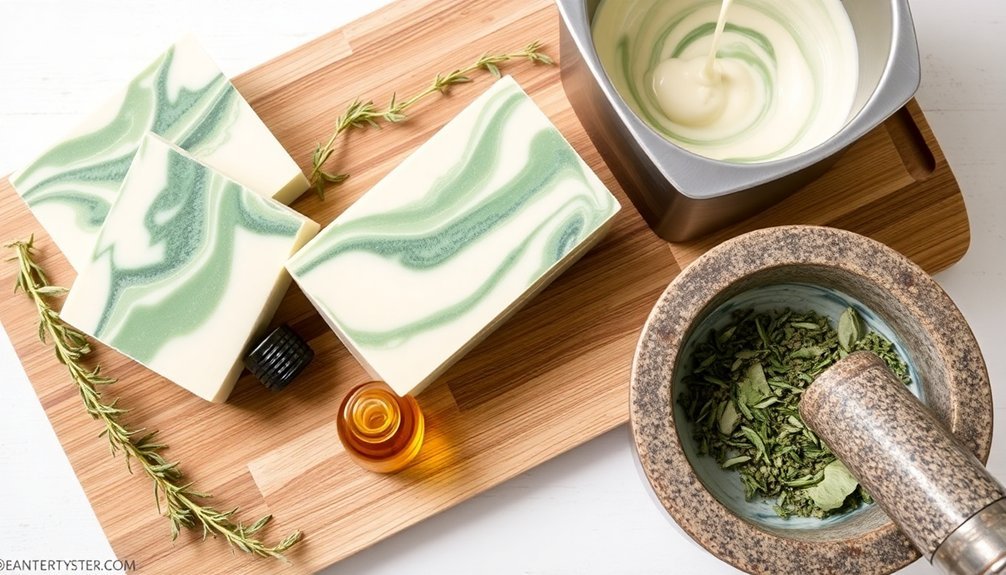
When creating homemade soap with rosemary extract, timing is everything. Harvest fresh rosemary immediately before infusion, adding about half a crock pot full for the best soap results. You can't store it, so use it right away.
Heat palm and olive oils on the warm setting of your crock pot, then add your dried rosemary. This infusion method enhances both color and potency.
After straining, weigh your infused oil precisely (for example, 1894 grams) before calculating percentages with a soap calculator.
For additional therapeutic benefits, whisk in rosemary and tea tree essential oils. Be gentle to incorporate air without creating bubbles.
Watch for color changes from red to green during saponification—this transformation is key to your handmade soap's final quality.
Oil Infusion Method: Capturing Rosemary's Essence
The oil infusion method stands at the heart of extracting rosemary's therapeutic properties. When working with fresh rosemary, harvest and clean it immediately, then fill your crock pot halfway—fresh rosemary can't be stored for later infusions.
Create your base by combining palm oil and olive oil, heating the palm oil briefly in the microwave first to achieve proper consistency. Set your crock pot to warm (not hot) to prevent cooking the rosemary while allowing oils to absorb its potency and color.
After infusion, strain the mixture carefully. Record the exact weight (1894 grams in our example) for precise soap making calculations.
These infused oils greatly enhance your soap's quality and therapeutic benefits—every measurement matters when formulating your perfect recipe.
Cold Process Incorporation Techniques
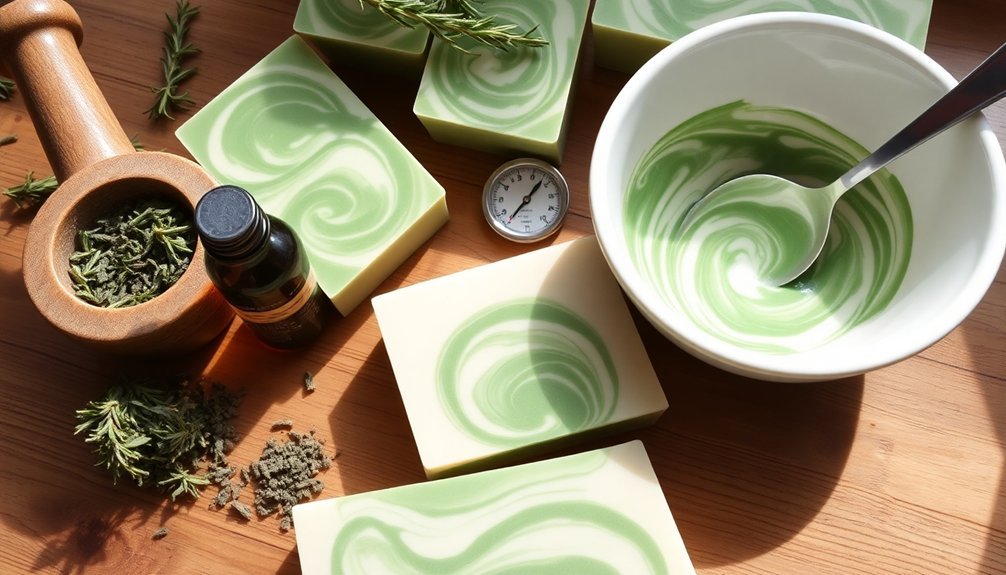
When adding rosemary extract to cold process soap, you'll need to evaluate whether to infuse it in oils beforehand or add it at trace for different benefits.
For the richest color and aroma, infuse your carrier oils with rosemary for 2-6 weeks before beginning your soap formulation.
If you're short on time, you can still achieve good results by adding strained rosemary extract at light trace, stirring thoroughly to guarantee even distribution throughout your soap batter.
Infusion Timing Strategies
Mastering the timing of your rosemary infusions can dramatically transform your cold process soap from ordinary to extraordinary. The key is maintaining temperature control below 100°F during your 4-6 hour crock pot infusion to preserve rosemary's beneficial properties.
You'll find that adding your infused rosemary oil at light trace creates even distribution throughout your soap batter.
- Infuse oils for a minimum of 4-6 hours on warm setting for maximum potency
- Thoroughly strain your infused rosemary oil before adding to remove all plant material
- Add the infusion at light trace for ideal incorporation and to prevent separation
- Enhance therapeutic benefits by combining a few drops of rosemary essential oil with your infused oil just before pouring into molds
This strategic timing approach guarantees your finished soap captures both the subtle herbal notes and skin-loving properties of rosemary.
Trace-Stage Addition Methods
Successful incorporation of rosemary extract during the trace stage requires precise timing and technique to maximize its benefits in cold process soap.
Add your rosemary extract when your soap reaches light to medium trace, as this guarantees ideal distribution while preserving its therapeutic properties.
When introducing the extract, whisk gently to prevent unwanted air bubbles while maintaining even integration throughout your mixture.
If you're seeking a more robust effect, consider using a strained rosemary essential oil that's been carefully infused in a crock pot.
Always monitor your soap's consistency as you add the extract—it should blend smoothly without causing premature setting.
Start with smaller amounts and gradually adjust to achieve your desired fragrance intensity, preventing the rosemary from overpowering your final product.
Hot Process Integration for Maximum Benefits
Although hot process soapmaking differs from cold methods, it offers unique advantages for rosemary extract integration. For ideal potency, infuse fresh rosemary in a blend of palm and olive oils using low heat in a crock pot. Use about half a crock pot of freshly harvested rosemary immediately—it can't be stored.
When calculating your oils, aim for precise measurement of the 1959 grams total, as this impacts your final soap quality.
- Add rosemary essential oil at light to medium trace for better scent retention
- Combine with tea tree oil for complementary properties while avoiding air bubbles
- Use the lye solution carefully after achieving proper oil infusion temperature
- Allow a full six-week cure time as saponification continues to develop color and pH
Creating Rosemary-Infused Water Bases
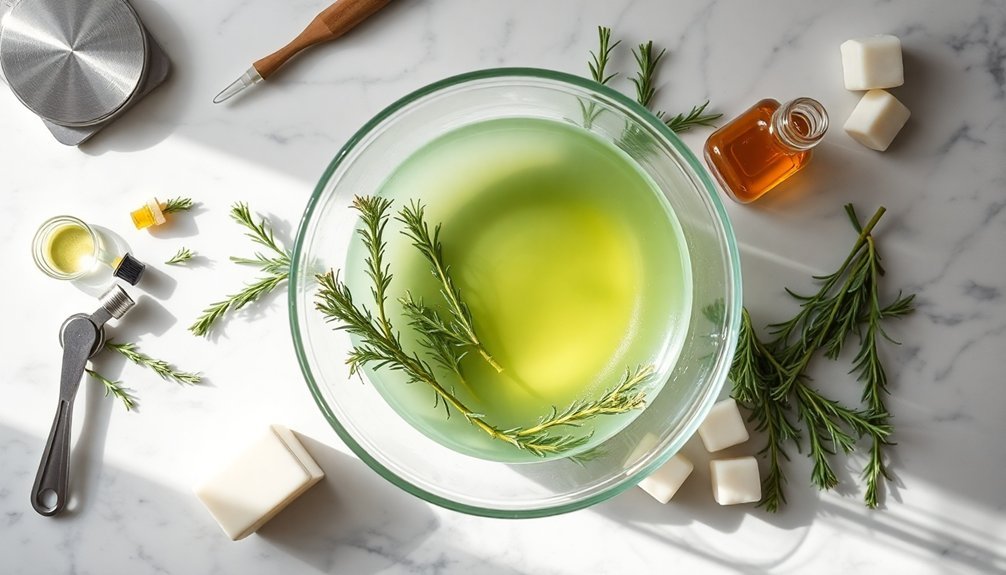
When you're looking to enhance your soap with rosemary's full spectrum of benefits, infused water bases offer an excellent alternative to oil infusions.
Start by boiling fresh herbs in distilled water for 15-20 minutes, extracting both aroma and beneficial compounds simultaneously.
After boiling, strain out the plant material and allow your rosemary-infused water to cool completely before use. This cooling step isn't optional—it's essential for safety when mixing with sodium hydroxide, as combining lye with hot liquid can cause dangerous reactions.
Always wear appropriate safety gear when working with lye solutions.
Use a 1:1 ratio of your infused water to lye solution in recipes, maintaining proper chemical balance. This method not only imparts rosemary's distinctive fragrance but also delivers its antioxidant properties directly to your finished soap.
Powdered Rosemary Extract Measurements and Timing
Powdered rosemary extract offers soapmakers a concentrated alternative to water or oil infusions. When measuring, stick to 1-3% of your total oil weight to achieve beneficial properties without overwhelming your soap's texture or fragrance profile.
Timing matters—add your extract after reaching a light trace during the mixing phase for even distribution.
- Create a slurry first by mixing your powdered rosemary extract with a small amount of oils to prevent clumping in your soap mixture.
- Watch for color changes as the extract may impart a greenish tint that evolves during curing.
- Monitor pH levels after adding the extract since it can slightly alter your soap's acidity.
- Incorporate during trace rather than earlier stages for maximum distribution throughout your soap mixture.
Layering Techniques With Varying Rosemary Concentrations
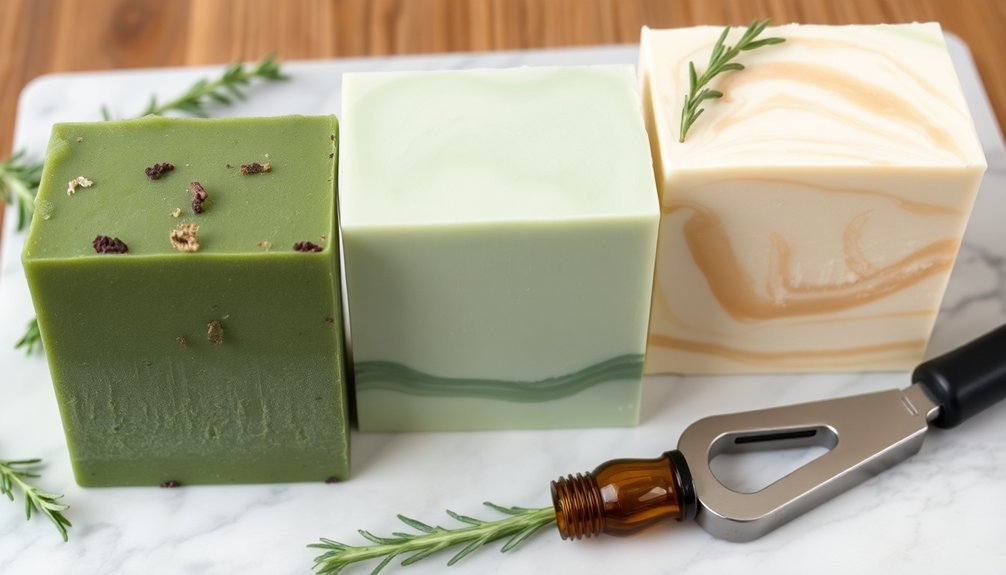
Layering soap with varied rosemary extract concentrations creates striking visual and therapeutic gradients that elevate your handmade products. Use a soap calculator to determine precise measurements for each layer, ensuring balanced formulations while experimenting with concentration variations.
| Layer Position | Rosemary Concentration | Technique | Effect |
|---|---|---|---|
| Top | Highest (3-5%) | Pour at light trace | Intense aroma release |
| Upper-middle | Medium-high (2-3%) | Add complementary oils | Shifting scent profile |
| Lower-middle | Medium-low (1-2%) | Swirl gently | Visual interest |
| Base | Lowest (0.5-1%) | Set partially | Foundation layer |
When creating multiple layers, allow each to develop a light skin before adding the next. This improves adhesion while maintaining distinct boundaries. Pair rosemary extract with complementary essential oils like lavender or citrus to create complex fragrance stories that unfold as your customers use the soap.
Frequently Asked Questions
How Much Rosemary Extract to Use in Soap?
You'll need approximately 1 tablespoon of rosemary extract per pound of base oils in your soap. Start with less if you're unsure, as potency varies, and you can adjust for your desired fragrance strength.
How Do You Add Extract to Soap?
Add extract to soap by infusing it in carrier oil first, then blend it into your soap mixture during emulsification. You'll want to use a stick blender initially, then switch to a whisk to avoid air bubbles.
How Do You Dilute Rosemary Extract?
Dilute rosemary extract by combining it with a carrier oil like olive or palm oil. You'll want to maintain a 1-3% concentration ratio of the total oil weight to avoid overwhelming your formulation.
How Do You Infuse Rosemary in Shampoo?
You'll infuse rosemary in shampoo by first steeping fresh rosemary in a carrier oil, straining it, then mixing 10-15% of this infused oil into your shampoo base. It's that simple yet effective!
In Summary
You've now explored seven effective ways to incorporate rosemary extract into your soapmaking projects. Whether you're infusing oils, layering different concentrations, or adding it during cold or hot processes, you'll find rosemary's antioxidant and skin-nourishing benefits enhance your soaps considerably. Don't hesitate to experiment with these techniques—you'll soon discover which method works best for your unique soap creations.

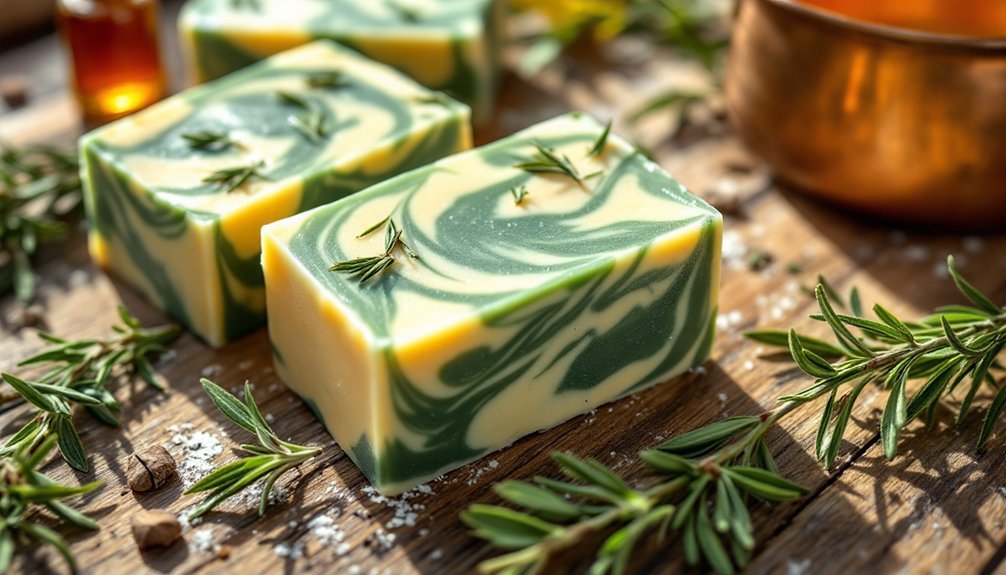



Leave a Reply